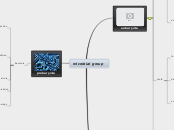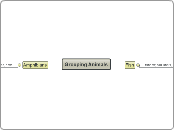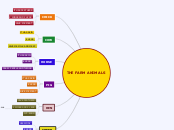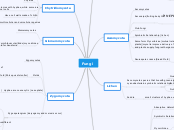Prokaryotic
a microscopic single-celled organism that has neither a distinct nucleus with a membrane nor other specialized organelles.
Bacteria
A lack of membrane-bound organelles.Unicellularity and thus division by binary-fission.Generally small size.
Eubacteria
Characteristics: Real Bacteria, unicellular prokaryotes, lack nucleus
Major Morphologies
Spirillum
Mice-Rats
Found in the blood of apparently healthy mice and rats.
Bacillus
widely found in soil and water
Bacillus Anthracis
Coccus
Staphylococcus Aureus
Archae
Characteristics: Unicellular (single celled), cells are plasmid (cell that can replicate independently of the chromosomes), and asexual.
Archaebacteria
Have cell walls, contain fatty acids, and have systems of metabolism (chemical reactions the living state of the cells and the organism).
Proteoarcheaeota
Eukaryotes
Characteristics: All animals, plants, fungi and protists. Cells have a nucleus and membrane-bound organelles
Animals
chordates
has internal skeletal rod, a complete digestive system, a ventral heart, a closed blood system and a tail; body symmetry: bilateral; eg. sharks, fishes, lizards frogs,humans
arthopoda
has jointed appendages (body extensions that give them a wide range of controlled motion); most successful because they are the most diverse, living in a great range of habitats; body symmetry: bilateral; eg. lobsters, centipedes, butterflies, spiders
Echindoermata
means spiky skin; dwells at the bottom of the ocean floor; body symmetry: radial eg. starfishes, sea lilies, sea urchins
Annelida
have long bodies that have segments divided externally by shallow rings; body symmetry: bilateral; eg. earthworms
Nementoda
aka the roundworms; very long and narrow; body symmetry: bilateral; eg. ascaris
Phatyhelminthes
aka flat worms; lacks a coelom and other body cavities; can be found in marine or fresh water; body symmetry: bilateral; eg. tapeworms
Mollusca
one of the largest phyla composed of many diverse organisms; all have a soft body; body structure composed of three parts; body symmetry: bilaterarl eg. octopus, snails, oysters
Cnidaria
contains cnidocyte or venomous cells that helps collect and transmit sensory information; body symmetry: radial eg. jellyfishes
Porifea
aka sponges; means animal that contains holes; are sessile feeders (stuck to the ground, eating what comes near them); body symmetry: asymetric eg. yellow tube sponge
Vertabrates
animals with backbones or spinal columns
aves
Amphibia
osteichthyes
chondrionthyes
agnatha (jawless)
Mammals
Placentals
Babies that are nourished by a placenta before being born. A placenta is an organ that allows a fetus to obtain nutrients from the mother's blood while the fetus develops inside the uterus. Humans are placental mammals.
Monotrems
lays eggs, platypus
Morsupials
babies that are not fully formed, and most marsupial mothers carry their young in pouches until they are more developed. Kangaroos are marsupials.
Chordates
Urchordata
tunicates (sea squirts)
Cephalochardata
amphioxus (or lanceles)
Vertabrata
backbone, fish birds reptiles
Arthopods
hard exoskeleton
Sub Phyla
Crustacea
crabs
Uniramia
butterflies
Checicerates
spiders
FUngi
Characteristics: Chemoheterotophic (cant make their own food), Reproduce thru spores, both sexual and asexual, usally not capable of motions, have cells walls composed of chitin.
Major Phyla
Basiciomycota
spores borne externally on a club-shaped structure called a basidium
Mushrooms
Ascomycota
spores borne internally in a sac called an ascus
Sac Fungi
Zygomycota
Sexual spores are thick walled resting spores called zygospores
Bread Molds
Chytridiomycota
sexual and asexual spores motile, with posterior flagella (hair like propellers)
Frogs
Plants
Angiosperm
a plant that has flowers and produces seeds enclosed within a carpel
Gymnosperms
seed-producing plants
Vascular
plants that have the vascular tissues xylem and phloem include all seed-bearing plants
Seedless
Photosynthesis occurs in the stems of whisk ferns, which lack roots and leaves.
Bryophytes
Bryophyte is a traditional name used to refer to all embryophytes that are non-vascular plants, namely the mosses, hornworts, and liverworts.
Protists
Characteristics: All are aquatic, mostly Unicellular (algae are multi), heterotophic (can not make its own food) or autotrophic (can make its own food) and has a nucleus.
Fungus-Like Protists
Saprophytic heterotrophic (digesting food externally and then absorbing it)
Slime-Molds
Water-Molds
Animal-Like Protists
Sporozoans
Do not move
Sarcodines
Movement: Pseudopods (false feet).
Ciliates
Movement: Tiny like hair that beat like a boat propelling through water
Zooflagellates
Movement: MOve by beating a long whip like flagella (hair like propellers)
Plant-Like Protists
Characteristics: Can move to find/ get food, Heterotrophic (can not make their own food)
Red Algae
Green ALgae
Brown Algae









